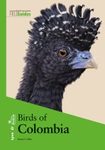Field / Identification Guide
By: Steven C Latta(Author), Christopher Rimmer(Author), Kent McFarland(Author), Dana Gardner(Illustrator), Barry Kent Mackay(Illustrator)
228 pages, plates with colour illustrations; colour distribution maps
![Field Guide to the Birds of the Dominican Republic and Haiti Field Guide to the Birds of the Dominican Republic and Haiti]()
Click to have a closer look
About this book
Customer reviews
Biography
Related titles
About this book
Field Guide to the Birds of the Dominican Republic and Haiti is the essential guide to birdwatching in these tropical countries. This completely revised and updated edition (published exclusively by Princeton University Press, with no separate UK edition being published by Helm) provides thorough accounts for more than 300 species, including details on new and endemic species.
Now conveniently organized by facing pages, the book features a wealth of images that includes 150 new illustrations by renowned artist Dana Gardner and range maps based on the most current data. Species descriptions present facts about key field marks, similar species, voice, habitats, geographic distribution, status, range, and local names used in the Dominican Republic and Haiti. The guide underscores the importance of promoting the conservation of migratory and resident birds, and building support for environmental measures.
Customer Reviews (1)
-
The best field guide for Dominican Republic
By
Keith
21 Feb 2023
Written for Paperback
It was way back in 2006 that the same authors collaborated with several others to write the first edition of this book. Although it was a softback, at 384 pages it was quite heavy and carried a lot of information on the species covered. By comparison this edition at 240 pages gives just the core identification which you actually need in the field and weight has reduced by 40%.
This new version has a much better layout with text facing the illustrations in typical field guide style. The latter have mostly been created by Dana Gardner with some from the original work from 2006 being repeated but 150 new images have been created and support has been sought from five other artists who have shared illustrations, some of which have appeared in other books. These all work well and are clear and groups such as seabirds, swifts, swallows and martins are shown in flight. There are monochrome distribution maps for every species excepting vagrants. Personally I prefer a bit of colour on these, but the truth is that birds here are either resident or winter visitors.
The taxonomy used is that of the AOU and where subspecies are mentioned they are those given in the BOU checklist to Hispaniola that was published in 2003. That said, the authors choose the name Green-tailed Ground-Tanager for what most people call Green-tailed Warbler, and similarly White-winged Warbler is called Hispaniolan Highland-Tanager. In addition they are ahead of other authorities in splitting two new species: Hispaniolan Elaenia (normally part of Greater Antillean Elaenia) and Hispaniolan Kingbird (part of Loggerhead Kingbird).
There are useful introductory chapters outlining the geography of the island and directing the reader to the 16 key sites. There is also information on conservation efforts that are underway. Depending on whose taxonomy you follow, there are over 30 endemic species to see (this book recognises 34) – more than any other Caribbean island. Only one of these (Grey-crowned Palm-Tanager) is restricted to Haiti which is currently suffering from roadblocks and local unrest. All of the others can be seen in the Dominican Republic, which is generally safe. With return flights costing less than £600 it’s a destination that should be on every birder’s bucket list.
4 of 7 found this helpful
-
Was this helpful to you? Yes No
Biography
Steven Latta is director for Conservation and Field Research at the National Aviary in Pittsburgh. Christopher Rimmer is executive director and Kent McFarland is founder and senior conservation biologist at the Vermont Center for Ecostudies. Dana Gardner is an author and illustrator. His many books include A Field Guide to the Birds of Malaysia & Singapore.
Field / Identification Guide
By: Steven C Latta(Author), Christopher Rimmer(Author), Kent McFarland(Author), Dana Gardner(Illustrator), Barry Kent Mackay(Illustrator)
228 pages, plates with colour illustrations; colour distribution maps
Reviews of the first edition:
"The illustrations are good and the concise text is free of waffle This new guide provides the travelling birder with all they need for a visit to this superb location and even those with a casual eye on the local wildlife will find it indispensable when trying to put a name to that hummingbird in the hotel garden."
– The Visitor (January 2007)
"I liked the book and if I ever go there for a trip I will certainly invest in it [...] A manageable field guide at a reasonable price."
– Scottish Bird News (June 2007)
"Will undoubtedly prove an invaluable field guide for residents and visitors [an] excellent guide that anyone interested in the birds of Hispaniola should have."
– IBIS (2007)


































